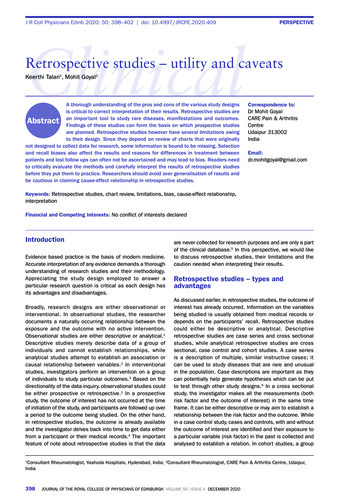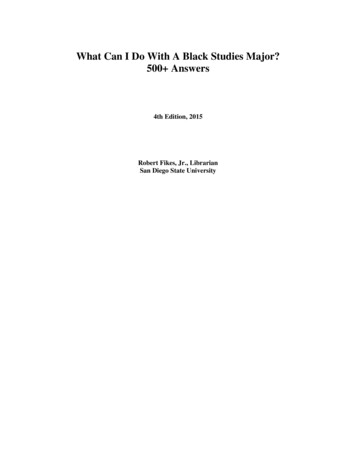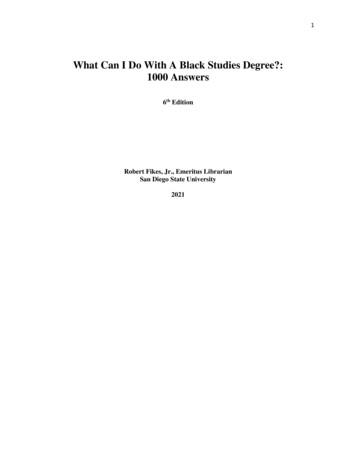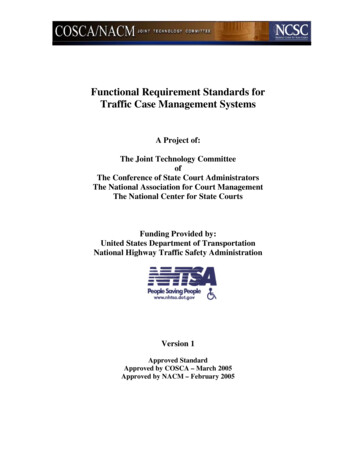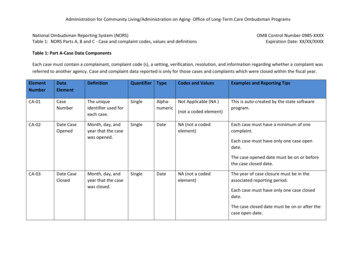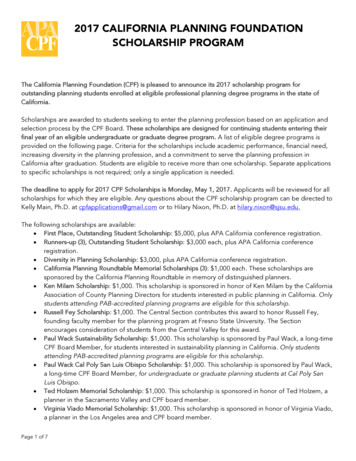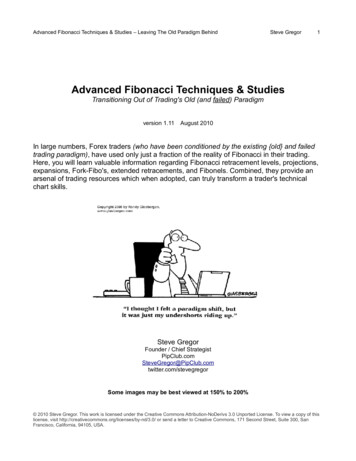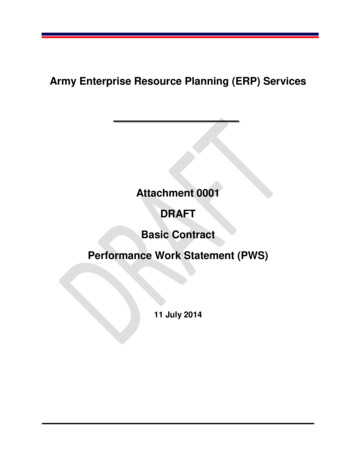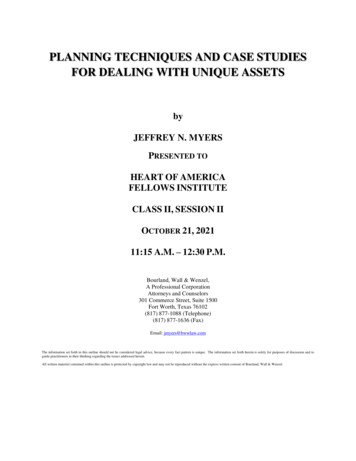
Transcription
PLANNING TECHNIQUES AND CASE STUDIESFOR DEALING WITH UNIQUE ASSETSbyJEFFREY N. MYERSPRESENTED TOHEART OF AMERICAFELLOWS INSTITUTECLASS II, SESSION IIOCTOBER 21, 202111:15 A.M. – 12:30 P.M.Bourland, Wall & Wenzel,A Professional CorporationAttorneys and Counselors301 Commerce Street, Suite 1500Fort Worth, Texas 76102(817) 877-1088 (Telephone)(817) 877-1636 (Fax)Email: jmyers@bwwlaw.comThe information set forth in this outline should not be considered legal advice, because every fact pattern is unique. The information set forth herein is solely for purposes of discussion and toguide practitioners in their thinking regarding the issues addressed herein.All written material contained within this outline is protected by copyright law and may not be reproduced without the express written consent of Bourland, Wall & Wenzel.
Speaker/AuthorJeffrey N. MyersBourland, Wall & Wenzel, P.C.Fort Worth, TexasEDUCATIONB.A., University of TexasJ.D., California Western School of LawLL.M. – Taxation, University of San Diego School of LawPROFESSIONAL ACTIVITIES, ACADEMIC APPOINTMENTS AND HONORSShareholder - Bourland, Wall &Wenzel, P.C.Fellow of the American College of Trust and Estate Counsel (ACTEC)Board Certified (Estate Planning and Probate Law) – Texas Board of Legal SpecializationReal Estate, Probate and Trust Law (REPTL) Council Member/Trust Committee Chair (20132017)Tarrant County Probate Bar – Board Member/SecretaryFort Worth Business and Estate Council – Board Member/ChairGUEST LECTURER IN ESTATE PLANNINGState Bar of Texas Advanced Estate Planning and Probate (2001, 2002, 2004-2007, 2011, 2013 –Course Director, 2014-15, 2018)State Bar of Texas Advanced Drafting – Estate Planning (2002, 2008, 2009; 2011 – CourseDirector)State Bar of Texas Advanced Estate Planning Strategies (2009-2012, 2014, 2015 – CourseDirector)Heart of America Fellows Institute (2019)University of Texas – Annual Taxation Conference (2006, 2015)Estate Planning Council of Central Texas (2017)DFW Philanthropy in Action (2017)Texas Tech School of Law Estate Planning and Community Property Law Journal (2009, 2015)State Bar of Texas 12th Annual Business Law Course (2014)Tarrant County Bar Association Firm Closing/Retirement Seminar (2014)State Bar of Texas Charitable Giving Program (2004)Center for American and International Law - 42nd Annual Program on Wills & Probate Law(2003)Texas Society of CPAs – Fort Worth Chapter (2000-2007)Brazos Valley Estate and Financial Planning Council (2001-2003)Texas Bankers Association Trust School II (2003-2007; 2012)State Bar of Texas - State Bar College Summer School (2006)Smith County Bar Association (2006)Annual Tax and Financial Planning Institute - McLennan Community College (2006-2008)Family Wealth Advisory Council Meeting (2007)Adjunct Instructor 1998-1999 – University of Texas at Arlington, Continuing Legal Education2
CASE STUDY EXAMPLE #1Creative Use Of Irrevocable Life Insurance Trust And Stock Purchase In Estate andFamily Business Succession Planning3
IRREVOCABLE LIFE INSURANCE TRUST PURPOSES Exclude life insurance proceeds from taxable estate Provide liquidity for estate taxes Replace assets given to charityFUNDING Normally Annual Exclusion gifts used to pay premiumsATTRIBUTES Irrevocable Life insurance proceeds in Grantor’s estate if Grantor dies within three years oftransfer of policy to trust Not subject to Generation-Skipping Transfer Tax if exemption applied to trust4
CASE STUDY EXAMPLE #1FACTS1.ABC Company is a “C” corporation owned by James Founder and Sally Founder. James Founderand Sally Founder have three children, James, Jr., William, and Carol. James, Jr. and William workin the business; Carol is not involved in the business. Each of the Founder children has threechildren of his/her own.2.James Founder and Sally Founder are the 100% owners of ABC Company stock (very low taxbasis) that has value of 15,000,000.3.James Founder and Sally Founder, each 65 years old, have combined estates worth 25,000,000, 15,000,000 (60%) of which is ABC stock. The remainder of their estates is illiquid, made up of(i) their home, a ranch, land and building on which ABC conducts business (from which theyreceive fair market value rental income) and profit sharing account of the Corporation, with acombined value of 10,000,000.4.Certain James and Sally Founder estate planning goals:(i) During their lives:(a) Take care of each other; and(b) Continue to work in and control the business for the rest of their lives (earning salaryand benefits during that time);(ii) Upon the death of the survivor:(a) Pass their interest in the family business to their two children participating in thebusiness;(b) Leave their estates in an equitable manner to their three children;(c) Reduce their federal estate taxes; and(d) Provide liquidity for the payment of their federal estate taxes.The Founders currently have “Simple Wills”. A Simple Will leaves all of a person’s estate to hisor her surviving spouse or to children equally (if spouse not surviving), with no transfer taxplanning and no special allocation of ABC Company stock to the two sons working in the familybusiness.A PLAN1.The Founders recapitalize ABC’s single class of stock (voting common) into voting and non-votingcommon stock and declare a stock dividend whereby 9 shares of non-voting common stock areissued for each share of voting common stock.2.The Founders then begin a program of Annual Exclusion gifts of non-voting ABC common stockto each son participating in the business, making an equitable gift annually to their daughter ofother property (probably undivided interests in the ranch-not equal gift because of the discountdifference). The stock and the ranch interests will receive a valuation discount for both lack ofmarketability and lack of control. The Founder sons and ABC execute a Buy/Sell Agreement whichplaces stock transfer restrictions on their stock under certain predetermined situations. Thisrestricts the transferability of the stock of the sons and also creates a fair market value opportunityfor their stock upon certain circumstances (i.e. death or disability funded with life insurance deathbenefit and cash value build-up). The Founders will execute a separate Buy/Sell Agreement withthe Irrevocable Life Insurance Trust described in 4 below. The Buy/Sell Agreement will requirethe estate of the Founders (or their successors in interests) to sell and the Irrevocable Life Insurance5
Trust to buy the shares of ABC owned by the Founders (or their successors in interest) at thesurvivor’s death. Therefore their stock will not be subject to stock transfer restrictions except atdeath of survivor. This will create a market after the last to die but will avoid having a marketcreated for it during life or at first death which would affect the valuation discount based on lackof marketability for lifetime or first death gifts/bequests.3.The Founders execute new Wills to take advantage of the Marital Deduction (i.e. QTIP Trust) andUnified Credit (i.e. Bypass/Exemption Equivalent Trust) allowed to their estates. The Wills benefitonly the survivor at the first spouse’s death. The children receive the benefits under the Wills onlyupon the survivor’s death. Any stock in the Corporation not gifted during life to the sonsparticipating in the business will not be specifically bequeathed to the sons. The transition of #4below will deal with stock in the corporation.4.The Founders create an Irrevocable Life Insurance Trust (i.e. Trust) making their two childrenworking in the business initial trustees and those two children and their children primarybeneficiaries. The Irrevocable Life Insurance Trust will purchase a joint and survivor life insurancepolicy on Mr. and Mrs. Founder to be used by the Trust to purchase ABC stock owned by the estateplanning trusts of the first to die and the estate of the survivor as well as provide funds to the estateof survivor by loan or asset purchase to pay estate taxes. The death benefit, if any, in excess of thatnecessary to purchase ABC stock will be equitably divided among the three children. This excessbenefit can be distributed to the three children or maintained in separate trusts for each of thechildren and their descendants, of which each child is trustee of his/her own trust.The death benefit in the Irrevocable Life Insurance Trust will not be subject to federal income orestate tax in the estate of either of the Founders or estates of children or children’s children if leftin Trust.The premium on the joint and survivor life insurance policy will be paid by Annual Exclusion giftsby the Founders to the Irrevocable Life Insurance Trust using the Founders’ grandchildren (whoare children of the sons working in the business) as Crummey gift beneficiaries and incomebeneficiaries of Trust while insurance contract exists. The grandchildren are also contemporaneousand successor primary beneficiaries to their parents of the trust benefits from the life insurance (i.e.a Dynastic Trust). Use of some of the federal generation-skipping transfer tax exemption will berequired because Dynastic Trust characteristics are desired.5.Upon the death of the last to die of Mr. and Mrs. Founder, the Irrevocable Life Insurance Trust willuse the life insurance proceeds to purchase the ABC stock owned by the estate planning trusts ofthe first to die and the estate of the survivor. Because of the federal income tax basis adjustmentof §1014, no capital gains tax will be paid on the purchase from the Marital Deduction Trust of thefirst to die or the estate of the survivor. To the extent the purchase is from the UnifiedCredit/Exemption Equivalent Trust of the first to die, capital gains tax may be paid because §1014basis adjustment is allowed only at the death of first to die and is not allowed at the survivor’sdeath. The Irrevocable Life Insurance Trust will then own the stock of the corporation that was notgifted to the sons during the Founders’ lives. The Founder sons will be co-trustees and equalbeneficiaries of the Trust (and the later sole trustee of trust that owns such son’s equal stock share)and thereby, along with the stock they each own individually, have equal control of the business.The life insurance proceeds that were paid to the estate planning trusts of the first to die and theestate of survivor will be used to pay the required estate taxes. Any remaining cash, along with therest of the assets of the Founders, will be divided among the three children. The division will bedone so as to provide overall equity in the distribution of the Founders’ estates among the threechildren through a funding formula in the Marital Deduction and Unified Credit/Exemption6
Equivalent Trusts of the first to die and the Will of the survivor. The funding formula will not bein the Irrevocable Life Insurance Trust. These provisions allow balancing of assets among theFounder children, considering the value of the assets of the Marital Deduction and UnifiedCredit/Exemption Equivalent Trusts of the first to die, the assets of the surviving parent’s estate,the assets in the Irrevocable Life Insurance Trust and the lifetime gifts to the children.7
CASE STUDY EXAMPLE #2Creative Use of Charitable Remainder Trust and Irrevocable Life Insurance Trust inEstate, Business Succession and Charitable Gift Planning8
CHARITABLE REMAINDER TRUSTAn irrevocable split interest trust benefiting non-charitable and charitable beneficiaries which: Pays no income tax on its income.Pays an amount of income and/or principal to the non-charitable beneficiary for CRT term, taxable to the non-charitablebeneficiary when received.CRT term either a term of years (not to exceed 20) or the lifetime of living individual.Pays the remainder to charitable beneficiary at the end of CRT term.Provides income, gift, estate and generation-skipping transfer tax charitable deduction to Grantor upon creation andfunding.CHARITABLE REMAINDER ANNUITY TRUSTA charitable remainder trust which: Pays a fixed percentage of the initial fair market value of trust assets or specific dollar amount, at least 5% and not morethan 50%, to the non-charitable beneficiary - “annuity amount”.The annuity amount does not fluctuate from year to year.CHARITABLE REMAINDER UNITRUSTA charitable remainder trust which: –––– Pays a fixed percentage of the fair market value of trust assets, valued annually, at least 5% and not more than 50%, to thenon-charitable beneficiary - “unitrust amount.”Standard CRUT – pays fixed percentageNICRUT – pays the lesser of income or a fixed percentageNIMCRUT – pays the lesser of income or a fixed percentage. The NIMCRUT would contain a provision which wouldrequire the trustee to pay deficiencies (the difference between the fixed percentage amount that could have beendistributed for a given year but for the income restriction and the amount that was actually distributed, i.e. the income)in future years to the extent the NIMCRUT has income in future years in excess of the fixed percentage amount.Income can include post contribution capital gain.FLIP/NICRUT or FLIP/NIMCRUT - combines the annual payment of the lesser of the fixed percentage of the CRUTassets, valued annually, or its income and the annual payment of the fixed percentage of the CRUT assets, valuedannually. Until the occurrence of a “triggering event,” the FLIPCRUT’s annual payment would be the lesser of thefixed percentage of the CRUT assets, valued annually, or its annual income (NICRUT or NIMCRUT). The firsttaxable year after the occurrence of the triggering event (and for the remainder of the CRUT term), the FLIPCRUT’sannual payment would be a fixed percentage of the FLIPCRUT assets, valued annually.The unitrust amount increases or decreases annually with the value of the trust assets.9
IRREVOCABLE LIFE INSURANCE TRUST PURPOSES Exclude life insurance proceeds from taxable estate Provide liquidity for estate taxes Replace assets given to charityFUNDING Normally Annual Exclusion gifts used to pay premiumsATTRIBUTES Irrevocable Life insurance proceeds in Grantor’s estate if Grantor dies within three years oftransfer of policy to trust Not subject to generation-skipping transfer tax if exemption applied to trust10
CASE STUDY EXAMPLE #2FACTS1.ABC Company (ABC or Corporation) is a “C” corporation owned by James Founder and SallyFounder. James and Sally have three children, James Jr., William, and Carol. James, Jr. andWilliam work in the business; Carol is not involved in the business. Each of the Founder childrenhas three children of his/her own.2.James and Sally are the 100% owners of ABC stock (very low tax basis) that has a value of 9,500,000, including 4,000,000 in cash on which income tax has been paid and that is notnecessary for day-to-day operations of the business.3.James and Sally, each 57 years old and in good health, have combined estates of 15,000,000, 9,500,000 (63%) of which is ABC stock. The remainder of their estates is illiquid, made up oftheir home, a ranch, land and building on which ABC conducts business (from which they receivefair market value rental income) and profit sharing account of the Corporation, with a combinedvalue of 5,500,000.4.Certain James and Sally Founder’s estate planning goals are:a.Immediately remove 4,000,000 in cash from the Corporation and to put it to work fortheir benefit outside ABC without paying additional income tax;b.During the next seven years stay in control of their business as shareholders and directorsand continue salary and benefits as employees;c.Seven years from now be completely out of ABC as shareholders, directors andemployees;d.Take care of each other during their lifetime;e.At their deaths:1)Provide a significant gift to public charity that will not reduce their children’sinheritance.2)Pass whatever portion of their stock (voting and non-voting) in ABC that has notalready gone to their two sons participating in the business to them in the most taxadvantageous manner;3)Divide their estates equitably among their three children;4)Provide liquidity for the payment of these taxes in a tax advantages manner.The Founders currently have “Simple Wills”. A Simple Will leaves all of a person’s estate to hisor her surviving spouse or to children equally (if spouse not surviving), with no transfer taxplanning and no special allocation of ABC Company stock to the two sons working in the familybusiness.A PLAN1.James and Sally Founder recapitalize ABC’s single class of stock (voting common) into voting andnon-voting common stock and declare a stock dividend whereby 9 shares of non-voting commonstock are issued for each share of voting common stock.2.The Founders then begin a program of Annual Exclusion gifts of non-voting ABC common stockto each son participating in the business, making an equitable gift annually to their daughter ofother property (probably undivided interests in the ranch – not equal because of discountdifferences). The stock and ranch interest will receive a valuation discount. The Founder sons andABC execute a Buy/Sell Agreement which places stock transfer restrictions on their stock under11
certain predetermined situations. This restricts the transferability of the stock of the sons and alsocreates a fair market value opportunity for their stock upon certain circumstances (i.e. death ordisability funded with life insurance death benefit and cash value build-up). The Founders will notexecute any Buy/Sell Agreement; therefore their stock will not be subject to stock transferrestrictions and will avoid having a market created for it which would affect the valuation discountbased on lack of marketability, for lifetime gifts or death transfers.3.The Founders execute new Wills that at the survivors death leave their sons equally any stock(voting and non-voting common stock) not given during their lives and an equitable amount ofother property (probably undivided ranch interests – not equal because of discount differences) totheir daughter. Their Wills take advantage of the Marital Deduction and Unified Credit allowed totheir estates. The Wills benefit only the survivor at the first spouse’s death. The children receivebenefit under the Wills only upon the survivor’s death.4.The Founders create an inter vivos Charitable Remainder Unitrust (FLIP/NIMCRUT) and fund itwith 4,000,000 (approximately 75%) of the non-voting common stock of ABC. The remainingnon-voting stock and all of the voting stock (except for Annual Exclusion gifts) will be retaineduntil the Founders retire from the business at which time they will gift it to their sons, with anequitable gift of the ranch interests to their daughter. This maintains control for James and Sallyuntil they are no longer economically tied to ABC. The non-voting common stock transferred tothe FLIP/NIMCRUT will receive a valuation discount (assume 40% -from 6,500,000 million to 4,000,000 million) for both lack of marketability and lack of control. The FLIP/NIMCRUT willhave the following attributes:a.b.c.d.5.It will pay an annual payment (Unitrust Amount) to James and Sally and the survivor in anamount equal to six percent of the FLIP/NIMCRUT’s value each year or theFLIP/NIMCRUT’s income (including post contribution capital gains) for that year,whichever is less (with a make-up in future years in which income is greater than sixpercent of the Unitrust’s value for that year, of the cumulative amount of all prior years’shortfall of net income as compared to six percent of each prior year’s value ofFLIP/NIMCRUT assets, i.e. make-up amount) for the first ten years. Beginning with theeleventh year the FLIP/NIMCRUT will FLIP (or change) and begin to pay a fixed UnitrustAmount equal to six percent of the value of the FLIP/NIMCRUT’s assets annually. At thattime, any unrecovered make-up amount will be forfeited.The Founders will be Trustees of the FLIP/NIMCRUT.The gift by the Founders to the FLIP/NIMCRUT will not result in any recognition of thecapital gain inherent in the non-voting stock given to the FLIP/NIMCRUT.The FLIP/NIMCRUT gift will generate an income tax charitable deduction equal to thepresent value of the future (remainder) interest to be given to public charities.Soon after the gift to the FLIP/NIMCRUT, ABC will use its cash to purchase the non-voting stockowned by the FLIP/NIMCRUT at the fair market value (discounted) of the stock at the time of thepurchase:a.b.To avoid the excise tax for self-dealing with FLIP/NIMCRUT assets by a disqualifiedperson, ABC must make the same offer to all ABC shareholders of the same class of stock.All economic relationships (other than reasonable compensation for personal services)between the FLIP/NIMCRUT and disqualified persons must be suspended while theFLIP/NIMCRUT owns Corporation stock, i.e. no rental payments or accrual of paymentson Founders land/building leased to Corporation.12
c.6.The gift, purchase and sale described in 4. and 5. above will have the following attributes:a.b.c.d.e.f.g.7.There must be no legal obligation prior to the stock gift to the FLIP/NIMCRUT that theFLIP/NIMCRUT sells its stock to ABC.The gift will reduce the value of the Founders’ taxable estates by approximately 6,500,000.The subsequent purchase and sale will move cash free of federal income tax to theFLIP/NIMCRUT (i.e., there will be no recognition of the gain inherent in the assets sold atthe time of the sale by the FLIP/NIMCRUT).The sale will provide liquid assets to the FLIP/NIMCRUT to enable it to diversify itsholdings and acquire property that can generate enhanced return for James and Sally. TheFLIP/NIMCRUT should invest for growth while the Founders continue as employees ofthe Corporation to allow Unitrust assets to grow while the Founders have their ABCcompensation to provide their support.Some of the Unitrust Amount paid by the FLIP/NIMCRUT as well as the taxes saved bythe charitable income tax deduction for the stock gift to the FLIP/NIMCRUT, can be usedto offset the cost of the premiums on the life insurance owned by an Irrevocable LifeInsurance Trust on the lives of James and Sally described in 7. below.The gift by the Founders and subsequent sale by the FLIP/NIMCRUT to ABC (i.e.corporate redemption) will reduce their issued and outstanding stock of the ABC, therebyincreasing the percentage of ABC ownership of the Founder sons working in the business,the last gift of remaining shares of voting and non-voting common stock giving the twosons 100% ownership and control of the business. This results in a federal estate and gifttax-free transfer of ABC ownership to the Founder sons.The purchase by ABC will result in a non-taxable dividend to the FLIP/NIMCRUT thatwill reduce the Corporation’s retained earnings.The Unitrust Amount paid to James and Sally will be characterized to the FLIP/NIMCRUTand taxed to them upon receipt as a redemption dividend because of their continuedownership of ABC, continued control of ABC and their continued employment by ABC.This characterization of Unitrust Amounts as redemption dividends will continue until thefull amount of unrecognized redemption gain has been taxed to them as UnitrustBeneficiaries. It is noted if the transaction of this Case Study Example occurs at the timeof the retirement of James and Sally Founder, James and Sally terminate all roles with ABCand execute the appropriate Internal Revenue Code waivers, the gain on the transactionwill be characterized to the FLIP/NIMCRUT and taxed to James and Sally as long termcapital gain.Finally, the Founders create an Irrevocable Life Insurance Trust (Trust) making all of their childrentrustees and children and grandchildren beneficiaries. The Trust will purchase a joint and survivorlife insurance policy on James and Sally in the amount of 6,500,000, plus or minus, an amountsufficient to accomplish the following objectives:a.To replace the value of the assets given to the FLIP/NIMCRUT.b.To provide liquidity for the payment of estate taxes.c.To aid in balancing the estate among the Founder children.(1)The death benefit in the Trust will not be subject to federal income or estate tax inthe estate of either of the Founders.(2)The premium on the joint and survivor life insurance policy will be paid by AnnualExclusion gifts by the Founders to the Trust using all of the Founders’grandchildren as (Crummey) annual withdrawal beneficiaries andcontemporaneous income beneficiaries with their parents of the Trust while the13
(3)8.insurance contract exists. This allows the Annual Exclusion gifts by the Foundersof other property to be made to the children, i.e. ABC stock to their sons in thebusiness and ranch interests to their daughter.The grandchildren are also contemporaneous, as well as successor beneficiaries totheir parents, of the Trust benefits from the life insurance proceeds (i.e. a DynasticTrust). Use of some of the federal generation-skipping transfer tax exemption willbe required because Dynastic Trust characteristics are desired.Upon the death of the last to die of James and Sally:a. The FLIP/NIMCRUT will terminate and the assets of the FLIP/NIMCRUT will pass to publiccharities chosen by James and Sally (as changed from time to time over their lifetimes). Thesurvivor’s estate will receive a 100% estate tax charitable deduction for the assets in theFLIP/NIMCRUT that are included in the survivor’s estate.b. The Trust will allocate the insurance proceeds for the benefit of the children and grandchildren,estate and income tax free.14
CASE STUDY EXAMPLE #3Creative Use of Family Limited Partnership, Non-Grantor Charitable Lead Annuity Trust,Intentionally Defective Grantor Trust and Private Foundation in Estate, Business Successionand Charitable Gift Planning15
CHARITABLE LEAD TRUSTAn irrevocable split interest trust benefiting charitable and non-charitable beneficiaries using present valuecalculations to leverage transfer tax strategies which: Pays an amount of income and/or principal to the charitable beneficiary for its term and pays theremainder to children or others at the end of term;Grantor receives a gift or estate tax charitable deduction for the present value of the interest passingto charity;Grantor receives an income tax charitable deduction upon creation and funding for the present valueof the interest passing to charity if “grantor” charitable lead trust, but does not receive an income taxcharitable deduction upon creation and funding if “non-grantor” charitable lead trust;Trust pays income tax on trust income during trust term if it is “non-grantor” charitable lead trustwith annual income tax charitable deduction and Grantor pays income tax on trust income duringtrust term if it is “grantor” charitable lead trust, without a corresponding annual income tax charitablededuction; and,Charitable beneficiary payment term is a term of years or lifetime of living individual or individuals,with required close relationship to Grantor.CHARITABLE LEAD ANNUITY TRUSTA charitable lead trust which: Pays a fixed percentage of the initial fair market value of trust assets or specific dollar amount (no5%/50% requirement) to the charitable beneficiary - “annuity amount”.The annuity amount does not fluctuate from year to year.CHARITABLE LEAD UNITRUSTA charitable lead trust which: Pays a fixed percentage of the fair market value of trust assets (no 5%/50% requirement), valuedannually to charity- “unitrust amount.”The unitrust amount increases or decreases annually with the value of the trust assets.16
FAMILY LIMITED PARTNERSHIPPlanning tool to own and transfer from one generation to succeeding generations familybusinesses, real estate interests and investment assets. It can be custom designed to meet eachparticular family situation. Top ten (10) reasons for selecting the family limited partnership as aplanning tool in ascending order of importance: Limitation of Payroll Taxes. Accumulation of Wealth. Family Training in Management and Growth of Assets. State Taxes/Income Tax Flexibility. Valuation Discount. Consolidation of Assets. Asset Protection – Inside and Outside of Family Limited Partnership. Separate Property Maintenance/Pre-Marital Planning. Continuity of Management. Control, Control, Control.Increasingly subject to challenge by the Internal Revenue Service based upon the ability to transfer assetsowned by the family limited partnership to succeeding generations at a discounted value. Of particularconcern are family limited partnerships utilized to transfer investment assets to the next generation at adiscounted value. Areas of possible attack by the Internal Revenue Service include the following: Lack of Bona Fide Business Purpose/ Withdrawal Rights. “Applicable Restriction” under Section 2704 of the Internal Revenue Code. Formalities of Partnership. Gift Upon Creation. Step Transaction Doctrine. Single Testamentary Transaction. Bona Fide Sale/Adequate, Full Consideration – 2036 (a)17
PRIVATE FOUNDATIONA non-profit corporation or irrevocable trust which: Receives charitable contributions from its creator and others. Enables donor to receive an income tax charitable deduction for property contributedduring life: Deduction limited to 30% of donor’s adjusted gross income for gift when donation iscash Deduction limited to 20% of donor’s adjusted gross income for gift of appreciatedqualified publicly traded stock when donation is attributed to value of the qualifiedpublicly traded stock Deduction limited to 20% of donor’s adjusted gross income for gift of appreciatedproperty, other than qualified publicly traded stock, and donation is attributed to basisof donated asset Enables donor to receive a full estate, gift and GST tax charitable deduction for propertycontributed. Makes annual grants to public charity, as selected by the foundation’s board of directors,in an amount equal to at least 5% of the annual fair market value of foundation’s assets. Pays a 2% excise tax (can be reduce
3. The Founders execute new Wills to take advantage of the Marital Deduction (i.e. QTIP Trust) and Unified Credit (i.e. Bypass/Exemption Equivalent Trust) allowed to their estates. The Wills benefit only the survivor at the first spouse's death. The children receive the benefits under the Wills only upon the survivor's death.


